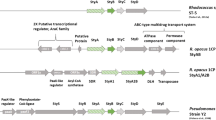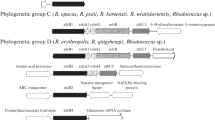Abstract
Styrene monooxygenases (SMOs) are catalysts for the enantioselective epoxidation of terminal alkenes. Most representatives comprise a reductase and a monooxygenase which are encoded by separate genes (styA, styB). Only six presumed self-sufficient one-component SMOs (styA2B) have previously been submitted to databases, and one has so far been characterized. StyA2B can be supported by another epoxidase (StyA1) encoded by styA1, a gene in direct neighborhood of styA2B. The present report describes the identification of a further styA1/styA2B-like SMO, which was detected in Rhodococcus opacus MR11. Based on the initially available sequences of styA2B-type SMOs, primers directed at conserved sequences were designed and a 7,012-bp genomic fragment from strain MR11 was obtained after PCRs and subsequent genome walking. Six open reading frames (ORFs) were detected and compared to genomic fragments of strains comprising either two- or one-component SMOs. Among the proteins encoded by the ORFs, the monooxygenase StyA1/StyA2B showed the highest divergence on amino acid level when comparing proteins from different sources. That finding, a rare distribution of styA2B genes among bacteria, and the general observation of evolution from simple to complex systems indicate that one-component SMOs evolved from two-component ancestors. Analysis of gene products from styA/styB- and styA1/styA2B-like SMOs revealed that a fusion of styA/styB to styA2B might have happened at least twice among microorganisms. This points to a convergent evolution of one-component SMOs.




Similar content being viewed by others
References
Tischler, D., & Kaschabek, S. R. (2012). In S. N. Singh (Ed.), Microbial degradation of xenobiotics. Environmental Science and Engineering (pp. 67–99). Heidelberg: Springer.
Montersino, S., Tischler, D., Gassner, G. T., & van Berkel, W. J. H. (2011). Advanced Synthesis and Catalysis, 353, 2301–2319.
van Berkel, W. J. H., Kamerbeek, N. M., & Fraaije, M. W. (2006). Journal of Biotechnology, 124, 670–689.
Kantz, A., Chin, F., Nallamothu, N., Nguyen, T., & Gassner, G. T. (2005). Archives of Biochemistry and Biophysics, 442, 102–116.
Otto, K., Hofstetter, K., Roethlisberger, M., Witholt, B., & Schmid, A. (2004). Journal of Bacteriology, 186, 5292–5302.
Hollmann, F., Lin, P.-C., Witholt, B., & Schmid, A. (2003). Journal of the American Chemical Society, 125, 8209–8217.
van Hellemond, E. W., Janssen, D. B., & Fraaije, M. W. (2007). Applied and Environmental Microbiology, 73, 5832–5839.
Nikodinovic-Runic, J., Flanagan, M., Hume, A. R., Cagney, G., & O'Connor, K. E. (2009). Microbiology, 155, 3348–3361.
Tischler, D., Eulberg, D., Lakner, S., Kaschabek, S. R., van Berkel, W. J. H., & Schlömann, M. (2009). Journal of Bacteriology, 191, 4996–5009.
Tischler, D., Kermer, R., Gröning, J. A. D., Kaschabek, S. R., van Berkel, W. J. H., & Schlömann, M. (2010). Journal of Bacteriology, 192, 5220–5227.
De Mot, R., & Parret, A. H. A. (2002). Trends in Microbiology, 10, 502–508.
Liu, L., Schmid, R. D., & Urlacher, V. B. (2006). Applied Microbiology and Biotechnology, 72, 876–882.
Munro, A. W., Girvan, H. M., & McLean, K. J. (2007). Biochimica et Biophysica Acta, 1770, 345–359.
Torres Pazmiño, D. E., Winkler, M., Glieder, A., & Fraaije, M. W. (2010). Journal of Biotechnology, 146, 9–24.
Kim, B. S., Kim, S. Y., Park, J., Park, W., Hwang, K. Y., Yoon, Y. J., et al. (2007). Journal of Applied Microbiology, 102, 1392–1400.
Roberts, G. A., Grogan, G., Greter, A., Flitsch, S. L., & Turner, N. J. (2002). Journal of Bacteriology, 184, 3898–3908.
Dorn, E., Hellwig, M., Reineke, W., & Knackmuss, H.-J. (1974). Archives of Microbiology, 99, 61–70.
Mitani, Y., Meng, X. Y., Kamagata, Y., & Tamura, T. (2005). Journal of Bacteriology, 187, 2582–2591.
Quan, S., & Dabbs, E. R. (1993). Plasmid, 29, 74–79.
Lenke, H., Pieper, D. H., Bruhn, C., & Knackmuss, H.-J. (1992). Applied and Environmental Microbiology, 58, 2928–2932.
Gorlatov, S. N., Maltseva, O. V., Shevchenko, V. I., & Golovleva, L. A. (1989). Microbiology (Mikrobiologiya), 58, 647–651.
Dabrock, B., Keßler, M., Averhoff, B., & Gottschalk, G. (1994). Applied and Environmental Microbiology, 60, 853–860.
Sensfuss, C., Reh, M., & Schlegel, H. G. (1986). Journal of General Microbiology, 132, 997–1007.
Seto, M., Kimbara, K., Shimura, M., Hatta, T., Fukuda, M., & Yano, K. (1995). Applied and Environmental Microbiology, 61, 3353–3358.
Mongodin, E. F., Shapir, N., Daugherty, S. C., DeBoy, R. T., Emerson, J. B., Shvartzbeyn, A., et al. (2006). PLoS Genetics, 2, e214.
Sambrook, J., Fritsch, E., & Maniatis, T. (2001). Molecular cloning: a laboratory manual (3rd ed.). Cold Spring Harbor: Cold Spring Harbor Laboratory Press.
Gröning, J. A. D., Tischler, D., Kaschabek, S. R., & Schlömann, M. (2010). Journal of Basic Microbiology, 50, 499–502.
Wei, M., Deng, J., Feng, K., Yu, B., & Chen, Y. (2010). Analytical Chemistry, 82, 6303–6307.
Moiseeva, O. V., Solyanikova, I. P., Kaschabek, S. R., Gröning, J., Thiel, M., Golovleva, L. A., et al. (2002). Journal of Bacteriology, 184, 5282–5292.
Altschul, S. F., Madden, T. L., Schäffer, A. A., Zhang, J., Zhang, Z., Miller, W., et al. (1997). Nucleic Acids Research, 25, 3389–3402.
Altschul, S. F., Gish, W., Miller, W., Myers, E. W., & Lipman, D. J. (1990). Journal of Molecular Biology, 215, 403–410.
Staden, R. (1996). Molecular Biotechnology, 5, 233–241.
Higgins, D. G., & Sharp, P. M. (1988). Gene, 73, 237–244.
Thompson, J. D., Gibson, T. J., Plewniak, F., Jeanmougin, F., & Higgins, D. G. (1997). Nucleic Acids Research, 25, 4876–4882.
Felsenstein, J. (2005). PHYLIP (Phylogeny Inference Package) version 3.6. Distributed by the author. Seattle: Department of Genome Sciences, University of Washington.
Ishikawa, J., Yamashita, A., Mikami, Y., Hoshino, Y., Kurita, H., Hotta, K., et al. (2004). Proceedings of the National Academy of Sciences of the United States of America, 101, 14925–14930.
Tan, G., Gao, Y., Shi, M., Zhang, X., He, S., Chen, Z., et al. (2005). Nucleic Acids Research, 33, e122.
Velasco, A., Alonso, S., Garcia, J. L., Perera, J., & Diaz, E. (1998). Journal of Bacteriology, 180, 1063–1071.
König, C., Eulberg, D., Gröning, J., Lakner, S., Seibert, V., Kaschabek, S. R., et al. (2004). Microbiology, 150, 3075–3087.
Bestetti, G., Galli, E., Ruzzi, M., Baldacci, G., Zennaro, E., & Frontali, L. (1984). Plasmid, 12, 181–188.
Toda, H., & Itoh, N. (2012). Journal of Bioscience and Bioengineering, 113, 12–19.
Bundy, B. M., Campbell, A. L., & Neidle, E. L. (1998). Journal of Bacteriology, 180, 4466–4474.
Eulberg, D., Kourbatova, E. M., Golovleva, L. A., & Schlömann, M. (1998). Journal of Bacteriology, 180, 1082–1094.
Solyanikova, I. P., Maltseva, O. V., Volmer, M. D., Golovleva, L. A., & Schlömann, M. (1995). Journal of Bacteriology, 177, 2821–2826.
Acknowledgments
The work was supported by a predoctoral fellowship from the Deutsche Bundesstiftung Umwelt (DBU). We are grateful to M. Sadowsky and J. Ferguson (University of Minnesota, USA) for providing the Arthrobacter strain TC1 as well as to J. Ishikawa (National Institute of Infectious Diseases, Japan) for providing a plasmid harboring a genomic fragment of the Nocardia strain IFM 10152.
Author information
Authors and Affiliations
Corresponding author
Additional information
Dedicated to the memory of Dr. Rakesh Jain
Electronic supplementary material
Below is the link to the electronic supplementary material.
ESM 1
(DOC 81 kb)
Rights and permissions
About this article
Cite this article
Tischler, D., Gröning, J.A.D., Kaschabek, S.R. et al. One-Component Styrene Monooxygenases: An Evolutionary View on a Rare Class of Flavoproteins. Appl Biochem Biotechnol 167, 931–944 (2012). https://doi.org/10.1007/s12010-012-9659-y
Received:
Accepted:
Published:
Issue Date:
DOI: https://doi.org/10.1007/s12010-012-9659-y




